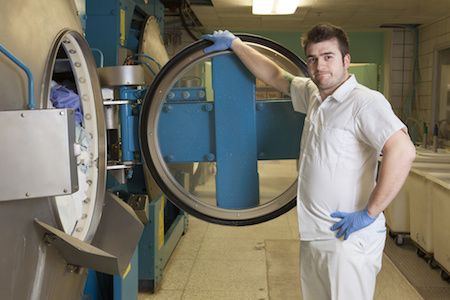Article
Hospital Laundry Group Disputes C. difficile Danger
Author(s):
Key Takeaways
- The TRSA disputes claims of laundry facilities as C. difficile sources, citing lack of significant contamination on the clean side.
- Laundries follow strict protocols, including inspections and testing, to ensure minimal contamination risk.
In a letter, the Textile Rental Services Association strongly responded to the article. David F. Goldsmith, MSPH, PhD, wrote that the story on hospital laundry facilities could “misleadingly create false alarms.â€

Responding to a MD Magazine article about laundry facilities being a possible source for Clostridium difficile (C. difficile) infection, the Textile Rental Services Association (TRSA) takes issues with the findings published in FEMS Microbiology letters.
In a letter from Joseph Ricci, president and CEO, the TRSA strongly disputed the article. He said the story could “misleadingly create false alarms.”
The TRSA letter pointed out that as no significant contamination was found on the clean side of the laundry facility, the conclusion that soiled linen contamination was a risk to laundry workers seemed baseless. The group also said there was a reasonable expectation that soiled linen areas could be more vulnerable to contamination when compared to clean areas.
The number of documented cases of C. difficile infection passed from laundry to employee or patient or other healthcare provider had no statistical bearing, the letter said.
“Laundering hospital textiles provides the linchpin to prevent transmission of contamination from soiled linen,” said Ricci. “Laundries demonstrate that they can accomplish this by becoming certified to a standard such as TRSA’s Hygienically Clean Healthcare that requires their facilities to be inspected and frequent laboratory testing to verify they meet independently established cleanliness requirements enforced around the world.”
While the article, “Hospital Laundry Facilities Could Be Source of Clostridium Difficile Transmission,” quoted the study author as saying laundry facilities should be considered an extension of the healthcare environment when considering prevention methods, the TRSA countered that hospital and commercial laundry facilities undergo strict protocols to ensure minimal risk of contamination. For example, inspections and randomized testing are used to maintain the highest expectations of cleanliness, workers wear personalized protective equipment (PPE), as well as following strict guidelines pertaining to time, temperature, chemical and agitation levels during the cleaning process.
The TRSA has also developed the Six C’s alongside other healthcare professionals: Cover, Collect, Contain, Consolidate, Clean, Cooperate.
Additionally, the TRSA said healthcare facilities have more significant concerns for C. difficile infection spreading through their hospitals beyond their laundry facilities. One of these concerns is the spread of C. difficile through scrubs worn by nurses are at risk because of their direct patient care, frequent contact with the patients’ environment, and because nurses often wear these scrubs home and launder them themselves. By doing that, home laundering services often cannot reach temperatures appropriate for decontaminating the bacteria.
Another MD Magazine article, “Hospital Bed CDI Transmission: Does Prior Occupant's Antibiotic Use Increase Risk?” underlined that the next occupant of a hospital bed could be at risk if the previous patient contracted C. difficile while at the hospital.
Related Coverage:
Hospital Laundry Facilities Could Be Source of Clostridium Difficile Transmission
California Hospital Staff Concerned about Facility's C. difficile Risk
Consumer Reports Compiles List of Hospitals by Rates of C. difficile Infection





